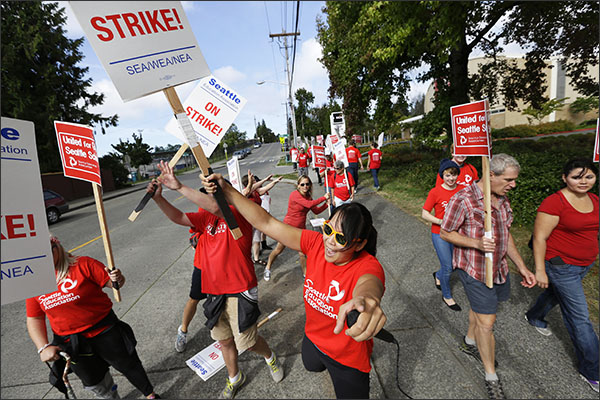Download a PDF of this policy note with sources and citations here.
Key Findings
In states with right-to-work laws, workers can choose not to join a union and not be fired. States without right-to-work laws force workers to pay union dues. They are “compelled riders.”
“Compelled riders” are forced to accept union representation even if they would prefer to represent themselves when negotiating with employers.
Opponents of worker protections say non-union members are “free riders” who benefit from union representation without sharing in the cost.
Federal law does not obligate unions to represent non-members. Unions only represent non-union workers when union executives take on exclusive bargaining representation.
Exclusive bargaining gives unions a monopoly. Employees may not represent themselves when negotiating with their employer, nor may any other union compete for membership.
In a case of circular reasoning, union executives use their monopoly position to compel workers to pay dues, then label these reluctant workers “free riders” when the workers say they don’t want union representation.
The solution is a policy of Worker’s Choice; release public employees from unwanted union representation and relieve unions from providing services to workers who do not want them.
Worker’s Choice would enable public sector employees to represent themselves. Unions would then negotiate separately on behalf of their own members.
Worker’s Choice would serve the public interest because public-sector workers would not be forced to pay union dues as a condition of employment, and the civil rights of all workers would be protected.
Introduction
The push for workers to gain legal right-to-work protection, the right of a person to hold a job without having to pay dues to a union, is steadily taking center stage across the country, as state leaders strive to improve their ability to create jobs, promote economic development and attract new businesses. Lawmakers in three states, Indiana, Michigan and West Virginia, recently enacted right-to-work protections, also called “workplace freedom” or “workplace choice,” with more states introducing legislation and debating the issue every year. Currently 26 states have right-to-work laws that protect workers.
In states with right-to-work laws, workers can choose not to join a union and not pay dues without being fired. States without right-to-work laws do not allow workers that choice, instead requiring employees to pay union dues or “agency fees” as a condition of employment. In these states, union executives require that workers who do not pay union dues be terminated.
Summary of the “free rider” problem
Opponents of worker protections says right-to-work laws give non-union members a “free ride” in the workplace, enabling them to benefit from union representation and union-secured benefits without sharing in the cost of negotiating those benefits. They argue the “free riders” ultimately result in more and more workers leaving the union, undermining the stability and financing of the union itself. For that reason opponents often describe efforts to pass right-to-work laws as “union-busting.”
This study explores the myth behind the “free rider” argument against right-to-work protections and offers a policy alternative that would satisfy unions’ concern.
Background
As more and more states debate whether a right-to-work law is right for their state, the issue has become increasingly charged with campaigns of misinformation and rhetoric.
For example, a right-to-work law does not prohibit employees from voluntarily joining a labor union, nor does it prohibit them from paying union dues voluntarily. Labor unions operate in right-to-work states, but the law protects each workers’ civil rights and freedom of association by prohibiting the payment of union dues from being a required condition of employment. The purpose of a right-to-work law is to protect anyone from being forced to choose between paying money to a cause he or she might oppose and making a living.
The arguments against right-to-work claim such laws are designed to cripple unions by allowing “free riders” to take advantage of the representation and services provided by a union without sharing in the cost. Right-to-work opponents say federal law requires unions to represent all workers at a company, whether or not they pay union dues, leaving unions in an impossible situation. As one union executive puts it:
“Under a right-to-work law, people could withdraw from the union and wouldn’t have to pay anything. But we are still obligated by federal law to represent them like we would represent a member.”
This statement is not accurate.
Federal law does not obligate unions to represent non-members. Under the National Labor Relations Act, unions can represent only their dues-paying members under a “members-only” contract. The benefits secured under these contracts apply only to dues-paying members. As noted by the former chairman of the National Labor Relations Board William Gould, “the law now permits ‘members-only’ bargaining for employees.”
Unions are only required to represent non-union workers if union executives choose to take on exclusive bargaining representation. Exclusive bargaining representation gives unions a monopoly, because it specifies that only one union may organize and represent employees in a unit. Employees may not represent themselves when negotiating with their employer, nor may any other union compete for membership.
This monopoly bargaining option means a union has decided to represent and negotiate on behalf of all employees in a company, regardless of whether every employee wants that representation. It also eliminates competition from other unions seeking to represent the same workers.
However, if unions opt for exclusive representation, the law then requires them to negotiate equally for all workers. That is, as the exclusive representative, the union cannot negotiate a lower wage that discriminates against non-members.
If a union decides against exclusive monopoly bargaining, it is not required to represent non-members. In that case only the members with a signed contract are required to pay dues and the union negotiates only for those members. In practice unions almost always seek exclusive representation status, since it gives them a monopoly position in the workplace.
One study explains the advantages union executives gain when they choose exclusive representation in the workplace:
“They [unions] prefer exclusive representative status because it enables them to get a better contract for their supporters. Consider seniority systems: They ensure that everyone gets raises and promotions at the same rate, irrespective of individual performance. If a union negotiated a members-only contract with a seniority system, high-performing workers would refuse to join.
Those workers would negotiate a separate contract with performance pay. The best workers would get ahead faster, leaving less money and fewer positions available for those on the seniority scale. The union wants everyone in the seniority system—especially those it holds back.”
Circular reasoning
So unions make the decision to negotiate as an exclusive representative in order to reap the benefits monopoly status provides, then use that choice as the justification for forcing employees to pay for representation they may not want.
In a case of circular reasoning, union executives use their monopoly position to compel workers to pay dues and be represented by the union, then label these reluctant workers “free riders” when the workers say they don’t want union representation.
In non-right-to-work states, workers who refuse to join the union but must still pay union dues, or agency fees, as a condition of employment are forced to pay for representation that results in labor contracts that may be harmful to their economic interests.
For example, a high performing worker is required to pay for a contract that rewards workers who are lower performers, but who have greater seniority, and who thus receive higher wages and better benefits than they could otherwise earn.
The solution to the free rider/compelled rider problem
While union executives make the free rider argument against right-to-work protections, U.S. Supreme Court Justice Kennedy recently dismissed the claim that teachers who object to compulsory unionism are “free riders.” He noted that under the current system they are “compelled riders for issues on which they strongly disagree.”
A “compelled rider” is forced to accept union representation, even if he would prefer to represent himself when negotiating with employers. Workers differ in the values they place on compensation and working conditions; for example, one worker might prefer to work from home in exchange for a lower wage, while another worker might be happier earning a higher wage with a more traditional work schedule.
A solution that would solve the “free riders” and “compelled riders” problem is a policy of Worker’s Choice. As proposed by the Mackinac Center for Public Policy, a Worker’s Choice policy would release public employees from unwanted union representation and relieve unions from providing services to workers who do not want to join the union or pay union dues or agency fees.
Simply put, Worker’s Choice would enable public sector employees who opt out of union membership to represent themselves. They would negotiate their own wages, benefits and working conditions. Unions would have no duty to represent those employees and would negotiate separately on behalf of their members only.
This solution would benefit both workers and unions—it would eliminate the “compelled rider” problem for workers, and it would eliminate the “free rider” problem for unions.
Public sector unions would maintain their exclusive representation privilege, meaning only one union could organize employees in a unit, but the union would no longer be required to provide services to non-members as a condition of exercising that privilege. Non-members would represent themselves when negotiating wages, benefits and working conditions with their employer.
A Worker’s Choice policy for public sector workers should be non-controversial. Not only would such a policy address the concerns of both unions and workers, it is already the standard in the vast majority of workplaces. Nationally, just 11 percent of workers belong to a union. That means the other 89 percent of non-unionized workers negotiate their own wages, benefits and working conditions with employers without forced union representation.
According to Mackinac’s proposal, implementing a Worker’s Choice policy would require a simple change to most state’s public sector bargaining law.
Conclusion
A policy based on Worker’s Choice would benefit both public sector unions and workers in right-to-work states. The free-rider concerns of unions and compelled-rider concerns of workers would be resolved.
The unions who choose to take advantage of the benefits of exclusive representation but do not want nonmembers benefitting from their services would no longer be forced to represent workers who do not pay.
At the same time, workers would not be forced to accept the compensation and working conditions negotiated by the union, nor would they be forced to support union activities with which they may disagree. They would have the choice and the freedom to decide whether union representation benefits them.
This choice would also encourage public sector unions to become more responsive to workers, which would, in turn, improve the services and benefits offered by a union.
Most importantly, a policy of Worker’s Choice would serve the public interest, because public-sector workers would not be forced to pay union dues as a condition of employment, and the basic freedom-of-association civil right of workers would be protected.





